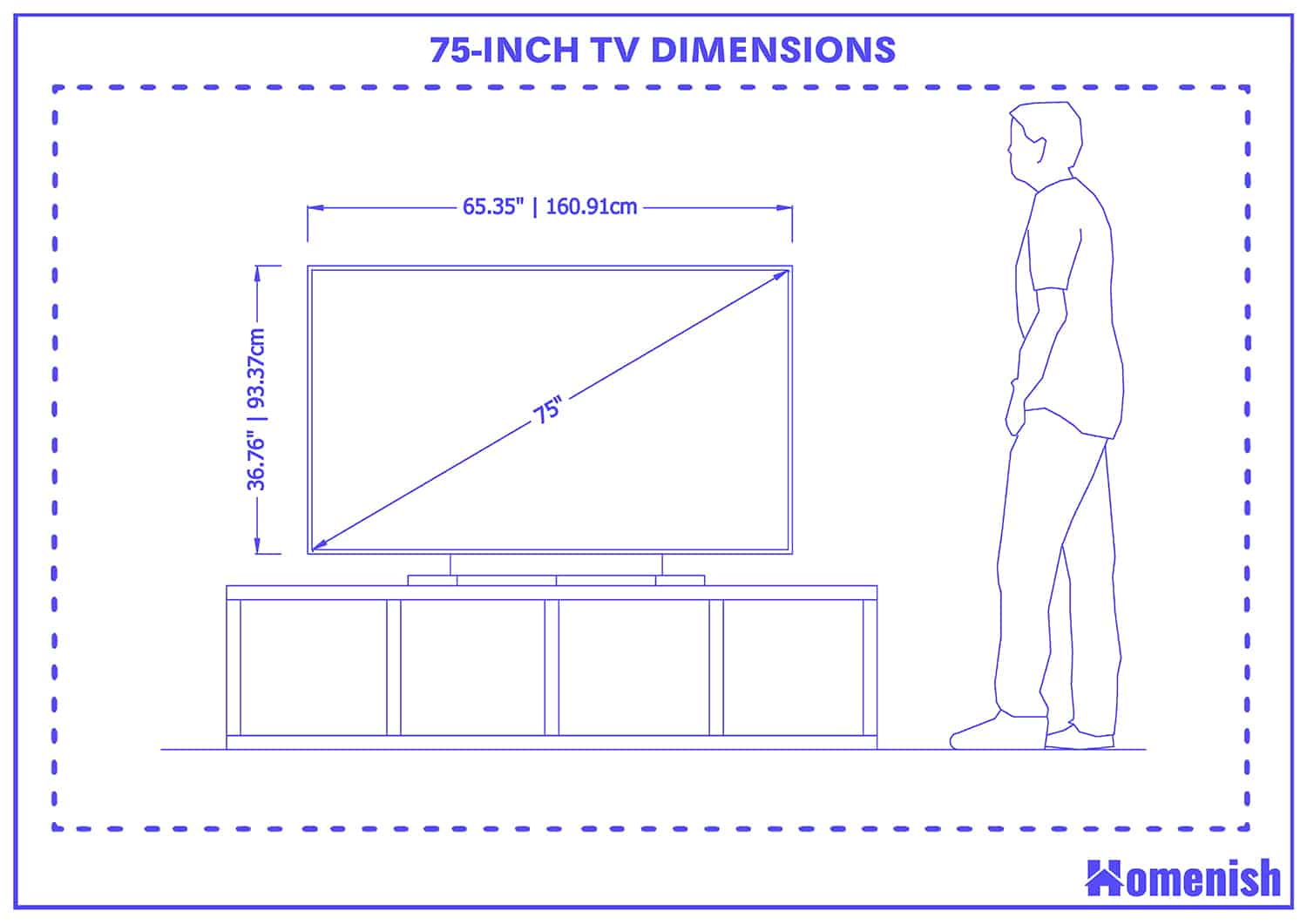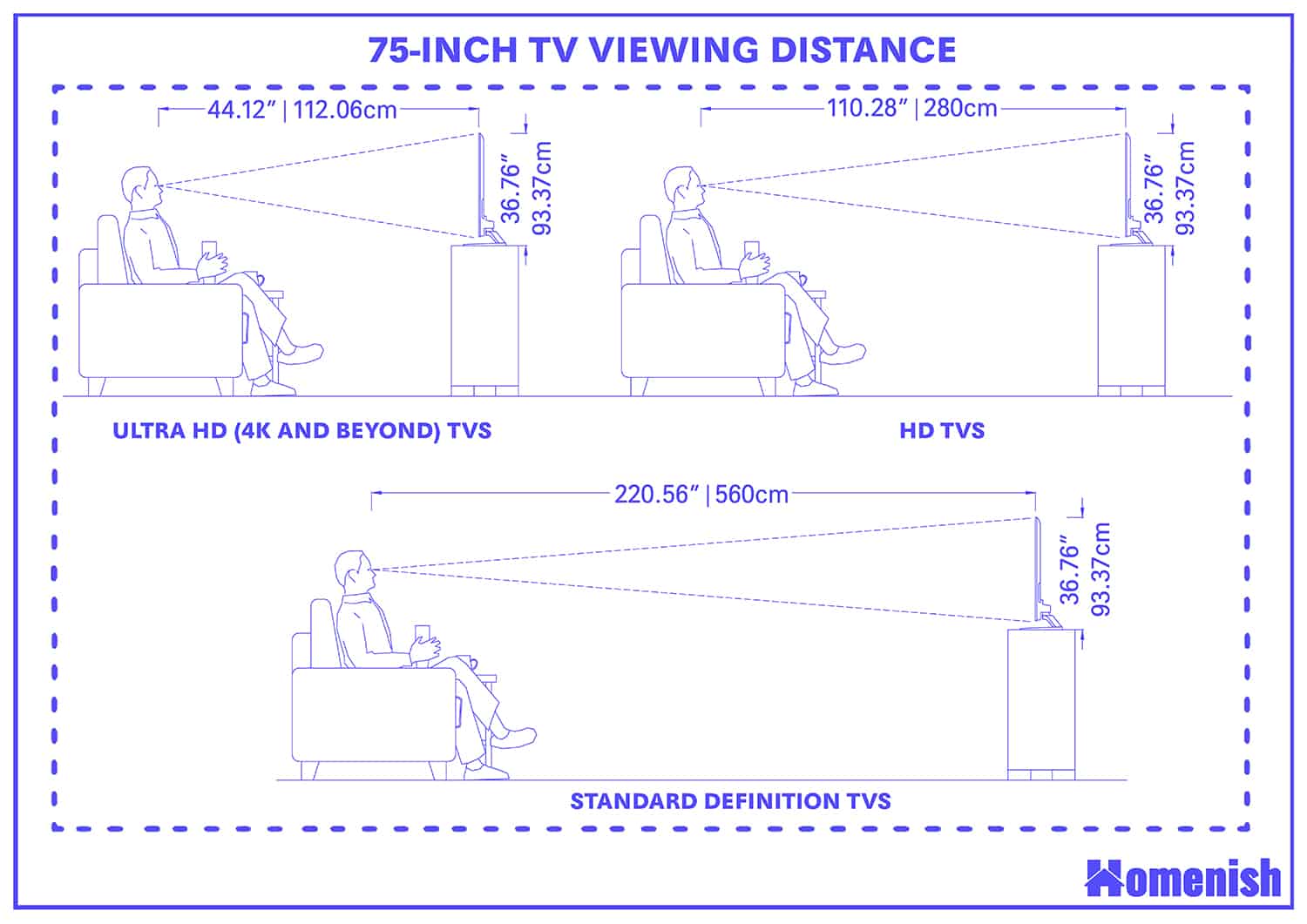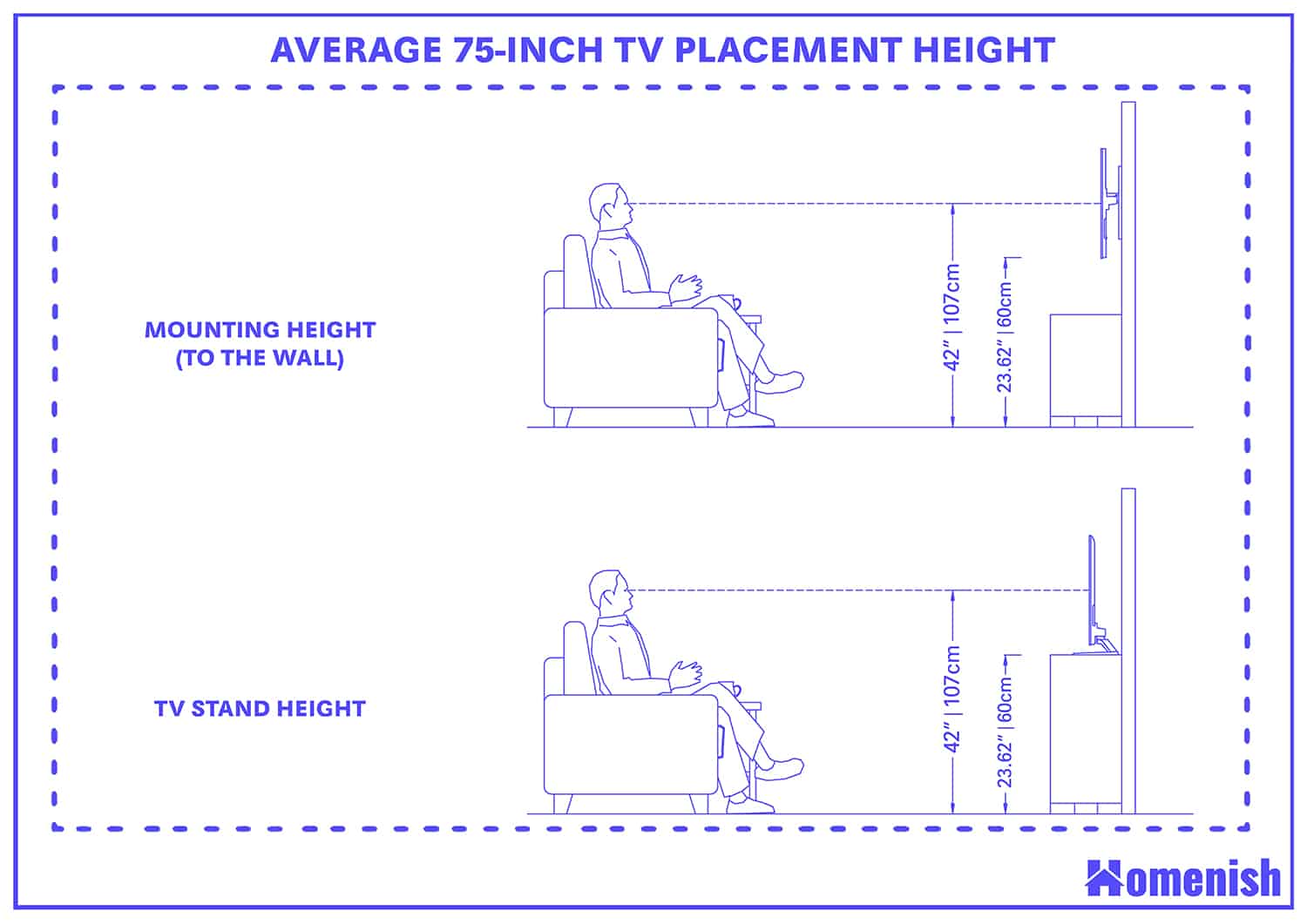You’re going to splurge on a brand-new TV and the 75-inch TV is on your to-buy list. But did you know that the 75 inches—only tells half the story? What are the height and length of a 75-inch TV and how much does it accommodate your space?
The dimensions of a 75-inch TV with a 16:9 aspect ratio will measure 65.35 × 36.76 inches (160.91 × 93.37 centimeters), taking up a total of 2,402.26 square inches (15,024.17 square centimeters) of space on a wall after mounting.
If you’d like to learn about measuring the dimensions of a 75-inch TV in greater detail, keep reading.
How Large Is a 75-inch TV?
The marketed size of a TV—in this case, 75 inches—doesn’t explain everything you need to know about its dimensions. After all, the 75-inch (190.50-centimeter) figure only refers to the diagonal length of the display.
We can break this figure down to determine the physical dimensions (W × H) of the TV by using a bit of simple mathematics.
But before we dive into the math, allow me to briefly describe aspect ratios to you.
Aspect Ratio
Any electronic with a screen—including TVs, monitors, and smartphones—will have an aspect ratio that is expressed in two numbers. The aspect ratio is the ratio of the display’s width to height.
The most common aspect ratios of TVs are 4:3, 16:9, and 21:9.
What these figures mean is that for every 4, 16, or 21 inches horizontally, the display will measure 3 or 9 inches vertically.
What you’ll find among most TVs, whether it’s 60 inches, 65 inches, or 75 inches, is that its aspect ratio will usually be 16:9. Ultra-wide TVs will come with an aspect ratio of 21:9. So, the calculations in the following segment will assume that the 75-inch TV has a 16:9 aspect ratio, for simplicity’s sake.
Calculating Screen Size
To calculate the physical dimensions of the TV’s screen, we have to know its height, width, and area. We can figure these out by using the following formulas:
- H = D ÷ √(AR2 + 1)
- W = AR × H
- A = W × H
So, let’s say you’re in the market for a 75-inch TV that has an aspect ratio of 16:9. The first step to calculate its physical dimensions would be to determine the height.
- H = D ÷ √(AR2 +1)
- H = 75 ÷ √(16:9)2 +1)
- H = 75 ÷ √(3.16 + 1)
- H = 75 ÷ √4.16
- H = 75 ÷ 2.04
- H = 36.76 inches (93.37 centimeters)
After knowing the TV’s height, we can input it into the formula to calculate the width, which is as follows:
- W = AR × H
- W = 16:9 × 36.76
- W = 1.78 × 36.76
- W = 65.35 inches (160.91 centimeters)
Now that we know the height and width, the final step is to multiply the two together to get the total area.
- A = W × H
- A = 65.35 × 36.76 inches
- A = 2,402.26 square inches (15,024.17 square centimeters)
In short, the dimensions of a 75-inch TV that has a 16:9 aspect ratio are 65.35 × 36.76 inches (160.91 × 93.37 centimeters) and will cover 2,402.26 square inches (15,024.17 square centimeters) of a wall. Please note that these figures do not take into account the TV’s bezels.
Since everyone loves math so much, let’s see what the 75-inch TV’s measurements would be if it had a 4:3 or a 21:9 aspect ratio.
If it had an aspect ratio of 4:3, the 75-inch TV would be 59.99 × 44.99 inches (152.37 × 114.27 centimeters) and cover 2,998.90 square inches (17,411.32 square centimeters) of a wall.
If it had an aspect ratio of 21:9, the 75-inch TV would be 68.93 × 29.54 inches (175.08 × 75.03 centimeters) and would take up 2,036.19 square inches (13,136.25 square centimeters) of wall space.
75-inch TV Room Sizes
Now that your TV is at home and still intact, the next natural thing to do is to determine how far away to mount the TV from your seating arrangement. We know—most of you guys probably only stick to what’s comfortable, and that’s actually completely fine. As long as you don’t strain your eyes, you can install it wherever you like.
As a good rule, to have an optimal distance, you can multiply the TVs’s height by 1.5 times, 3 times, and 6 times with the 4Ks and beyond TVs, HD TVs, and SD TVs respectively. The number would be 55.14 inches (4 feet 7 1/8 inches), 110.28 inches (9 feet 2 1/4 inches), 220.56 inches (18 feet 4 1/2 inches) in the order given.
With that said, the room sizes suggested for a 75-inch TV are
- For 4K and beyond 75-inch TVs, the room length or width should be a minimum of 6 feet.
- For HD 75-inch TVs, the room should be at least 9 feet 2 1/4 wide or long.
75-inch TV Placement Height
We already discussed how to find the exact height to place the TV in our 60-inch TV or 65-inch Tv guide. To determine the average TV mounting height on the wall, you can subtract half the TV height from the average eye level of an adult person when seated. Find the calculation below.
42″ – (36.76″ ÷ 2) = 23.62 inches (60 cm)
When using a TV stand, subtract another 2 to 3 inches of the TV leg height from the above figure to have the TV stand height.
23.62 inches – 2 inches = 21.62 inches (54.91 cm)
Note: In reality, this number should be increased as people tend to lay back on the sofa. The more you recline toward the sofa’s back, the higher the TV mount should be placed.
Will a 75-inch TV Fit Inside My Car for Transport?
If you bought a 75-inch TV at a brick-and-mortar retailer, can you stuff the TV inside your car, or will you have to pay for shipping?
A 75-inch TV can fit in the trunk and back seat of a large SUV or pickup truck while standing upright. If you drive a sedan or hatchback, you should seek alternative methods of transporting the TV to your home.
Earlier, we calculated that a 75-inch TV has a total area of 2,402.26 square inches (15,024.17 square centimeters). However, when transporting a TV, we have to think in three dimensions, as well as take into account the TV’s box.
The moving experts at Movers claim that 75-inch TV boxes typically measure 73 × 44 × 9 inches (185.42 × 111.76 × 22.86 centimeters).
Can your car handle that large of a box? Don’t forget to include how much space you’ll need to allocate to pillows and cushioning during the drive.









